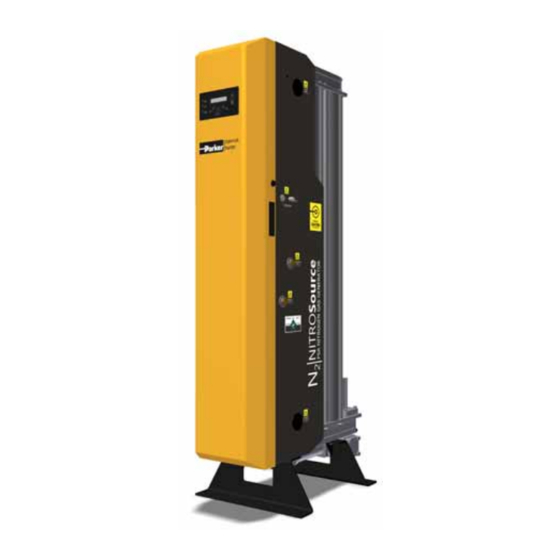
Summarization of Contents
Safety Information
1.1 Markings and Symbols
Identifies warning symbols and their meanings on the equipment and manual.
1.2 Personnel Definitions
Defines roles like Operator, Responsible Body, and Service Personnel.
Product Description
2.1 Technical Specifications
Provides performance data for different models under specific conditions.
Approvals and Compliance
2.2.1 Approvals and Standards
Lists directives and standards the equipment complies with.
2.2.2 Regulatory Compliance
States compliance with FDA and European Pharmacopeia for medical use.
Physical Characteristics
2.3 Weights and Dimensions
Details the physical dimensions and weights of different generator models.
2.4 Materials of Construction
Lists the materials used for various components of the generator.
Equipment Handling and Overview
2.5 Receiving, Inspecting, and Storing
Outlines procedures for checking, storing, and unpacking the generator.
2.6 Component Identification
Identifies key components and ports of the nitrogen generator.
Installation and Commissioning
3.1 Recommended System Layout
Illustrates an ideal setup for the nitrogen generator and associated equipment.
3.1.1 Compressed Air Pre-treatment
Explains the importance and types of air pre-treatment for optimal performance.
Locating the Equipment
3.2.1 Environmental Considerations
Specifies the ideal environmental conditions for generator installation.
3.2.2 Space and Clearance Requirements
Details the necessary clearance around the generator for operation and maintenance.
3.2.3 Air Inlet Quality Standards
Defines the required purity standards for compressed air input.
Mechanical Installation
3.3.1 General Requirements
Covers general guidelines for pipe-work installation and material selection.
Making Connections
3.3.2 Securing the Generator
Instructs on how to physically secure the generator to the floor.
3.3.3 Making System Connections
Details how to connect the generator to the system, including regulators and valves.
Electrical Installation
3.5 General Electrical Requirements
Outlines general electrical connection guidelines and cable management.
3.6 Customer Connections
Details various connection points for external systems and supplies.
Customer Connections Details
3.6.1 Mains Voltage Supply
Specifies requirements for connecting the generator to the main power supply.
Ancillary System Connections (Dryer & Purge)
Details connections for pre-treatment dryer and purge economy features.
Control and Monitoring Connections (Alarms & Remote)
Explains connections for remote alarms and start/stop control signals.
Advanced Communication and Outputs
3.6.6 4-20mA Analogue Output
Describes the 4-20mA output for transmitting oxygen content data.
3.6.7 MODBUS Networking
Provides information on setting up Modbus communication for networking.
Generator Operation and Configuration
Control Panel and Basic Operations (4.1, 4.2, 4.3)
Covers control panel layout, starting, and stopping procedures for the generator.
Menu Interface and Parameter Access (4.4)
Introduces the menu system for viewing operational data and settings.
Customer Settings and Parameter Details (4.4.3 & Page 23)
Details configurable parameters like oxygen alarms, operational modes, and communication settings.
Parameter Navigation and Modification
Guides users on how to navigate and change settings within the customer menu.
Generator Operating Modes
4.5 Oxygen Content Monitoring
Monitors residual oxygen and vents gas if alarm level is exceeded.
4.6 Economy Mode Operation
Switches generator to standby when no gas demand, with override option.
4.7 Energy Saving Technology - EST
Monitors O2 levels to optimize cycle times for energy saving.
Sensor Calibration Procedures
4.8 Oxygen Sensor Calibration
Provides a step-by-step guide for calibrating the oxygen sensors.
Preventative Maintenance
5.1 Cleaning Instructions
Instructions for cleaning the generator equipment.
5.2 Maintenance Schedule Overview
Outlines a schedule of required maintenance tasks based on time or usage.
Preventative Maintenance Kits
5.3 Preventative Maintenance Kits Listing
Lists kits required for scheduled preventative maintenance.
Preventative Maintenance Kit Contents
5.3.3 Kit Contents Detailed Breakdown
Details the components included in each preventative maintenance kit.
Troubleshooting Guide
6.1 Common Faults and Remedies
Provides a guide to identify and resolve common faults and issues.
Fault Codes Reference
Lists specific fault codes, their probable causes, and remedies.










Need help?
Do you have a question about the NITROSource N2-80P and is the answer not in the manual?
Questions and answers